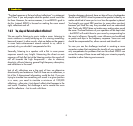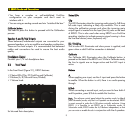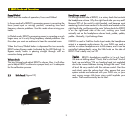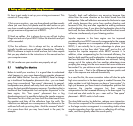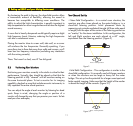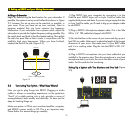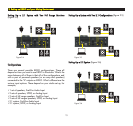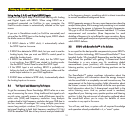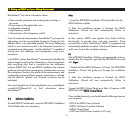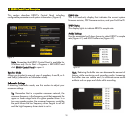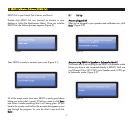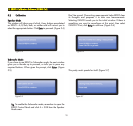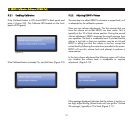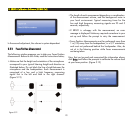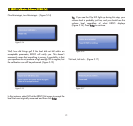
14
UUssiinngg AAnnaalloogg ((LL && RR)) aanndd DDiiggiittaall ((SSPPDDIIFF)) IInnppuuttss
Here
are a few tips to keep in mind when dealing with Analog
and Digital Inputs with ERGO. When using ERGO as a
soundcard connected via FireWire to your computer, the
FireWire audio stream is automatically selected as the input
source.
If you are in Standalone mode (no FireWire connected) and
using either the SPDIF Input or the Analog Inputs, ERGO selects
the audio source as follows:
1. If ERGO detects a SPDIF clock, it automatically selects
the SPDIF Input as its source.
• If ERGO has detected a SPDIF clock, but you want to use the
Analog Inputs, then you must use ERGO’s control panel to
select the Analog Inputs.
• If ERGO has detected a SPDIF clock, but the SPDIF Input
is not working, then ERGO was started in Analog mode.
Use the ERGO Control Panel to select the SPDIF Input.
• If the SPDIF Input is not working, ERGO is probably not
locking its clock to a SPDIF clock. Check your cables and the
audio output selection in your DAW application.
2. If ERGO does not detect a SPDIF clock, it automatically selects
the Analog Inputs as its source.
33..44 TTeesstt SSiiggnnaall aanndd MMeeaassuurriinngg TTeecchhnniiqquueess
To ge
t the necessary Room Knowledge, ERGO relies on a new
way of measuring the room. Using traditional test signals such
as pink noise, normally means a trade-off between signal-to-
noise ratio (SNR) and frequency resolution. Long analysis
windows lead to high frequency resolution but poor SNR due to
the low number of averages. But using multiple pure tones
means long analysis windows (5.5 seconds for low frequency
test signal) leading to both high frequency resolution (0.2 Hz)
AND an excellent SNR due to very narrow analysis bandwidth
in the frequency domain, something which is almost insensitive
to normal broadband background noise.
ERGO generates energy at the very same frequencies where the
analysis takes place, that is energy and processing is not wasted
by measuring the spaces in between the analysis frequencies.
Why go to all of this trouble? Because traditional 1/3 octave
measurement and correction (three frequencies for each
doubling of frequency) is not sufficient for room correction. Room
correction needs great analysis and powerful processing, both of
which ERGO delivers.
33..55 EERRGGOO wwiitthh RRoooommPPeerrffeecctt™™ iiss tthhee SSoolluuttiioonn
In
our quest for the best possible components to power ERGO’s
Room Correction technology, KRK licensed RoomPerfect™ from
Lyngdorf Audio. Why Lyngdorf? Because they are the best, and
they solved the problem with getting 3 dimensional Room
Knowledge in a very unique way. By combining global
measurements (room positions) with measurements at the
listening position, up to 8 corrected listening positions can be
calculated.
The RoomPerfect™ system combines information about the
listening position with information about the energy transport
into the sound-field in a completely new and innovative way. The
measurement at the listening position holds information about
the listener’s access to the sound-field while the room positions
hold information about the 3 dimensional sound-field in the
entire listening room. And so, perfect sound is rendered,
regardless of your listening room, speaker position and listening
position. In fact, the vast amount of information gathered about
the sound-field allows you to enjoy the benefits of room
correction in any spot in the room.
You will see, and hear, a system with all required knowledge
and operation already embedded in it, a “smart” system.
33.. SSeettttiinngg uupp EERRGGOO aanndd yyoouurr MMiixxiinngg EEnnvviirroonnmmeenntt



